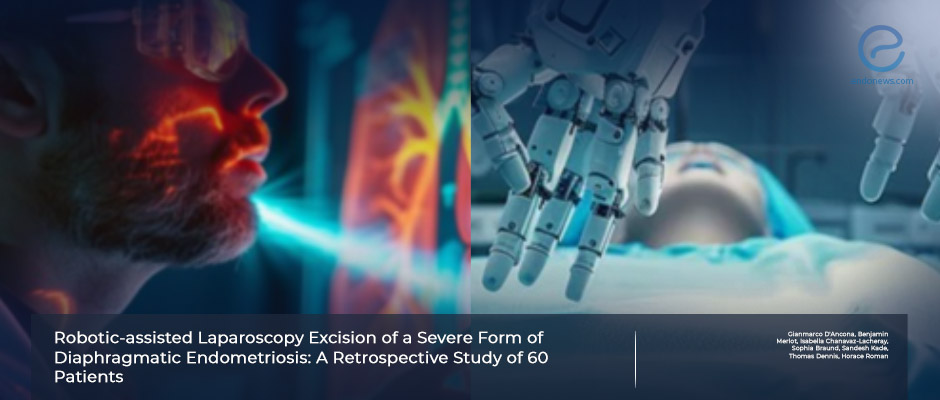Robotic-assisted laparoscopy to manage severe diaphragmatic endometriosis
Sep 5, 2024
Robotic-assisted laparoscopy is effective in expert hands to treat diaphragmatic endometriosis.
Key Points
Highlights:
- The benefit of radical deep endometriosis resection by robotic surgery for diaphragmatic endometriosis seems long-lasting with improved symptoms and complete pain relief after 12 months.
Importance:
- Robotic surgery in experienced hands is effective, safe, and feasible.
What's done here:
- A French author team conducted a retrospective single-center study in a tertiary referral hospital using data prospectively recorded from two endometriosis databases.
- The main objective was to assess robotic laparoscopy's feasibility, effectiveness, and safety on patients with severe diaphragmatic endometriosis.
- Categorial and continuous variables were evaluated and compared statistically with the data of 60 patients during 3 years between 2020 and 2023.
Key Results:
- Of the 60 operated patients, 49 completed follow-ups more than 12 months. The common baseline symptom was shoulder and arm pain, with a percentage of 86,7%.
- 88,3% of cases involved a multiple focal type of diaphragmatic lesion, 60% had nodules, and 16.7% had spontaneous diaphragmatic rupture.
- Stripping was the most commonly used robotic technique during the operation, either alone or in addition to diathermal coagulation, and partial and full-thickness resection.
- The distribution of patients according to stage and classification system showed a higher rate in stage IV patients, 62,7% rASRM and 76,4% AAGL.
- Full-thickness diaphragmatic resection was primarily performed by robotic technique (46/60); moreover, 10% of cases had a partial diaphragmatic resection.
- The most common postoperative complication was the herniation of diaphragms, which was corrected with surgical repair.
- Complete recovery of patients gradually increased during follow-up, reaching 89% after 12 months of surgery.
Lay Summary
Diaphragmatic endometriosis is a rare extrapelvic form of endometriosis, with specific symptoms experienced by 30%, such as shoulder, chest, arm, and right upper quadrant pain. An early diagnosis is vital to prevent the disease progressively toward the thoracic cavity, causing catamenial hemothorax and/or pneumothorax. For this reason, when deep endometriosis is strongly suspected, it is worth evaluating the diaphragm intraoperatively using a minimally invasive approach.
The published literature does not describe how to approach the diaphragm, which can be done laparoscopically or robotically. However, the laparoscopic approach has limitations regarding straight instruments and the narrowness of the Morrison pouch. The most challenging step is still the repair of diaphragmatic lesions, which requires high ability and surgical skill. Robotic surgery can overcome these limits and facilitate surgical procedures.
D'Ancona et al., from the Franco-European Multidisciplinary Institute of Endometriosis, Tivoli-Ducos Clinic, Bordeaux, France, realized the lack of literature in the field of robotic surgery for diaphragmatic endometriosis, hence planned to publish a single-center case series of patients presenting with symptomatic diaphragmatic endometriosis. They aimed to evaluate the safety, effectiveness, and feasibility of the robotic surgical approach to diaphragmatic endometriosis. This study, which has no comparison with the laparoscopic approach in similar areas, was recently published in the Journal of Minimally Invasive Gynecology.
All 60 patients were pathologically diagnosed with deep endometriosis after their first laparoscopic surgery and some were referred to their clinic. Some patients had catamenial pneumothorax requiring thoracoscopy. Postoperative clinical evaluation was performed 3 months after surgery. The patients were asked to fill out a questionnaire form about their symptoms on 3,6,12,24, and 36 months postoperatively.
In their series, there was a significantly higher rate of full-thickness diaphragmatic excision than the literature data. The reason was easy access to the diaphragm by robotic-assisted surgery which allowed complete removal of the lesions. The authors of this study concluded that their technique is safe and effective in skilled hands.
Research Source: https://pubmed.ncbi.nlm.nih.gov/38866098/
robotic-assisted laparoscopy diaphragmatic endometriosis surgical technique endometriosis.

